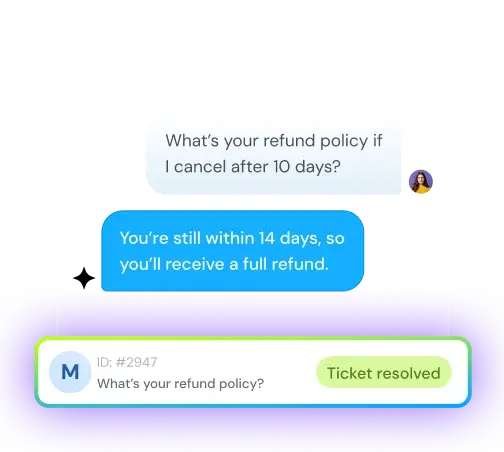Proactive vs reactive customer service: Which actually works better in 2025?
Sneha Arunachalam
Jul 30, 2025
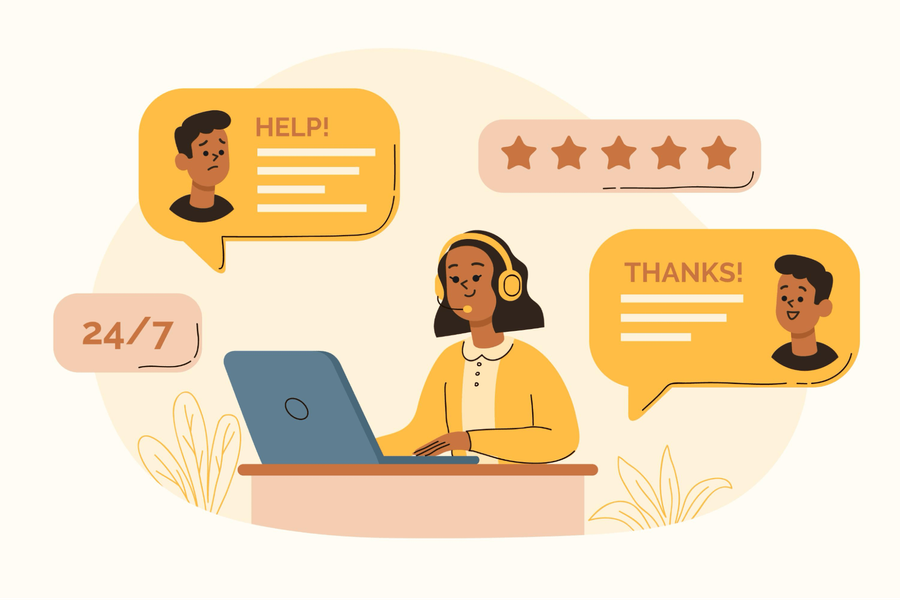
Customers don’t always complain when something goes wrong — they just leave.
That’s the reality businesses are facing in 2025. Most support teams are stuck reacting to problems after they happen, scrambling to fix issues before the customer walks away for good.
But what if you could catch those issues before they even reach the customer? That’s where proactive customer service steps in — spotting friction early, offering help before it’s asked for, and creating the kind of experience that keeps people coming back.
Of course, reactive customer service still has its place. You can’t predict everything, and when the unexpected happens, customers want fast, empathetic help. But in the debate of proactive vs reactive customer service, the most successful companies in 2025 aren’t picking sides — they’re combining both.
By blending forward-thinking support with responsive problem-solving, they’re staying ahead of customer expectations and building loyalty that lasts.
In this blog, we’ll break down each strategy, show you when and how to use them, and share real-world examples of businesses doing it right. By the end, you’ll have a clear roadmap to strike the right balance — one that anticipates needs and delivers when it matters most.
Understanding proactive vs reactive customer service
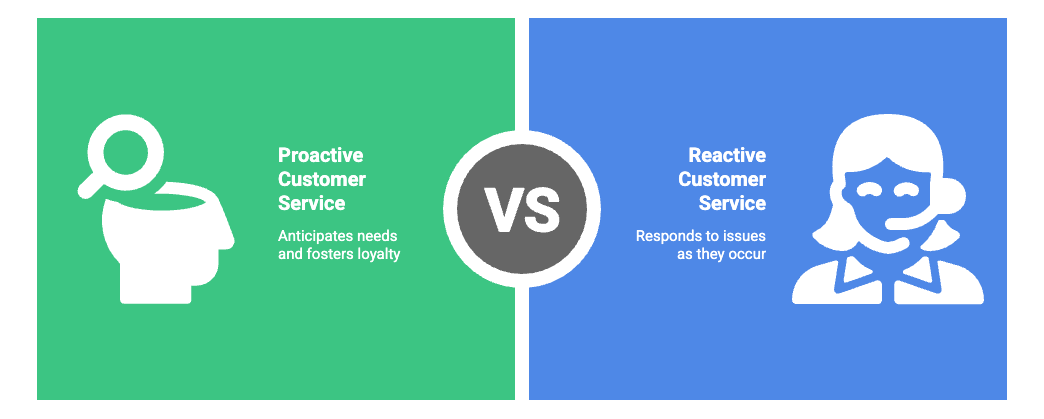
Both approaches have their place, but knowing when to use each one makes all the difference.
What is proactive customer service?
Proactive service means you make the first move. Instead of waiting for customers to contact you with problems, you reach out before issues even hit their radar.
Picture this — your system detects that a customer's order might be delayed. Rather than letting them wonder where their package is, you send a heads-up email explaining what's happening. That's proactive service in action.
The benefits are pretty obvious. You're stopping frustration before it starts, which builds serious trust with your customers. Plus, 81% of service professionals say customers now expect more personalized experiences than ever before. Getting ahead of problems shows you're paying attention.
What is reactive customer service?
Reactive service is the traditional approach — you wait for customers to come to you. They hit a problem, get frustrated, then reach out through your support channels.
Here's how it usually goes: customer finds an issue, sends an email or makes a call, then gets told someone will "look into it" and get back to them in a few days. Meanwhile, their frustration grows while they wait.
But let's be honest — reactive support isn't going anywhere. You can't predict every single thing that might go wrong. Sometimes customers need immediate, personal attention for issues that came out of nowhere.
Key differences between Proactive vs Reactive Customer Service
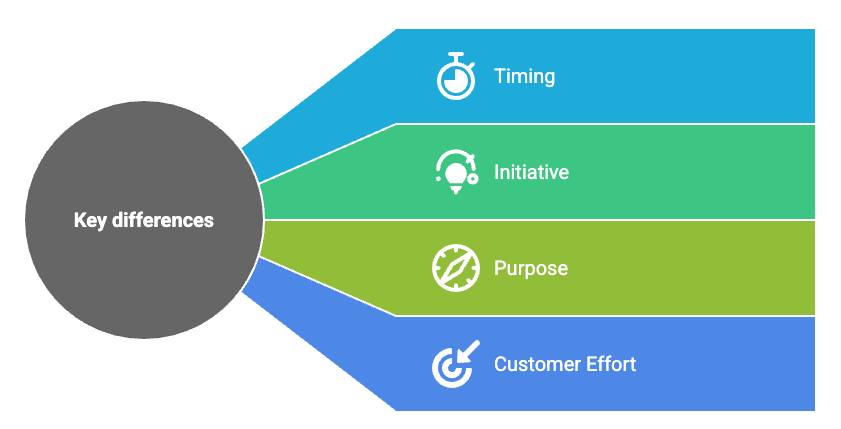
The main difference? Who makes the first move and when:
- Timing: Proactive tackles issues before they happen; reactive responds after problems surface
- Initiative: With proactive, you reach out first; with reactive, customers contact you
- Purpose: Proactive prevents problems; reactive solves existing ones
- Customer effort: Proactive eliminates the need for customers to seek help; reactive puts that responsibility on them
Think of it like car maintenance — proactive service is changing your oil regularly to prevent engine problems. Reactive service is fixing the engine after it breaks down. Guess which one costs more and causes more headaches?
That said, both approaches matter. Reactive service shines when dealing with unexpected, complex situations that need a human touch. Most successful businesses use both strategies together rather than picking just one.
For companies looking to grow in 2025, this balance has become crucial. Research shows 54% of customer service leaders now prioritize proactive customer service in their businesses.
When to use each approach
Both strategies have their place, but knowing which one to use when? That's where most companies get stuck. Let's break down when each approach actually makes sense for your business.
Scenarios best suited for proactive service
Some situations practically scream for a proactive approach:
When the same problems keep popping up. If your data shows customers hitting the same roadblocks — login troubles, payment hiccups, whatever — why wait for them to get frustrated? Fix it before it happens. It's like patching a hole in your roof instead of placing buckets around the house.
Your support team is drowning in tickets. With 89% of customers having higher expectations than ever, getting ahead of issues helps you manage that demand. Smart automation and self-service options can cut your ticket volume dramatically.
You want to build real relationships. Nothing says "we care" like solving a problem your customer didn't even know they had yet. That kind of foresight builds the kind of trust that keeps people coming back.
Cutting costs without cutting corners. Proactive service can reduce support costs because preventing problems is almost always cheaper than fixing them later. Plus, your team stays sane when they're not constantly putting out fires.
Situations where reactive service is more effective
But let's be honest — you can't predict everything. Reactive service still has its place:
Weird, one-off situations. When someone has a problem you've never seen before, reactive support gives you the flexibility to figure it out. These curveballs are impossible to anticipate.
Complex stuff that needs a human touch. Sometimes customers need someone who can really listen and understand their specific situation. No automated system can replace genuine empathy and problem-solving skills.
Budget reality check. Building a fully proactive system costs money upfront — analytics tools, automation software, the works. For smaller businesses, a solid reactive approach might be the smarter starting point.
Crisis mode. When something urgent hits, reactive support becomes your emergency response team. Speed matters more than prevention at that point.
How customer expectations influence the choice
Here's what really matters — what your customers actually want.
Customer expectations have shifted big time. About 89% of service professionals say expectations are higher than ever, and 81% report customers want more personalization. That sounds like a vote for proactive service, right?
Not so fast. Many customers still prefer reaching out on their own terms. Some people want you to anticipate their needs. Others want to control when and how they get help.
The sweet spot? Most successful companies use both approaches together — proactive where it makes sense, reactive where it's needed.
Smart businesses track what their customers actually prefer, not what they think customers should want. Monitor feedback, watch behavior patterns, and adjust accordingly. What works for one customer segment might annoy another.
The bottom line is this: the most effective customer service strategy combines both approaches. As one expert puts it, "The trick is providing a combination of proactive and reactive customer service. When used together, brands unlock the ability to deliver exceptional customer support every time, regardless of a customer's specific needs".
How to implement proactive customer service

Getting proactive service off the ground isn't about buying expensive software and hoping for the best. It's about building smart systems that actually work for your customers — and your team.
Use of data and analytics
Your customer data is like having a crystal ball, but only if you know how to use it. Smart businesses collect information from multiple sources — phone calls, emails, chat logs, social media mentions. All of it matters.
Here's how to think about what you're collecting:
- Quantitative stuff: Hard numbers like response times and call duration
- Qualitative insights: What customers actually feel about your product and service
With predictive analytics, you can spot trouble brewing before your customers even notice. Advanced AI algorithms analyze vast amounts of customer data in seconds, giving you insights into patterns and preferences. Your team can identify where people get stuck, what questions come up repeatedly, and offer help before anyone has to ask.
Setting up automated alerts and notifications
Smart notifications save everyone time and headaches. But here's the catch — they only work if you set them up right:
- Figure out what actually triggers customer problems
- Meet people where they are (email, SMS, whatever they prefer)
- Rank alerts by how urgent they really are
- Test everything before you go live
- Track what's working with real metrics
Think appointment reminders, billing heads-ups, inventory alerts, maintenance warnings. When these messages show up in the right place at the right time, customers feel taken care of instead of bothered.
Training teams to anticipate customer needs
Your team needs more than technical know-how — they need the instincts to spot problems coming. Focus your training on:
- Recognizing the warning signs when customers are getting frustrated
- Giving people permission to act without waiting for approval
- Teaching everyone how to read the data and spot patterns
Build simple flowcharts that show exactly what to do in different situations. When your team knows the game plan, they can move fast.
Creating self-service resources
Self-service isn't about making customers do your job — it's about giving them the power to solve things on their own timeline. Use AI-driven tools to offer personalized help instead of generic FAQ pages that nobody reads.
Focus on the 20% of questions that drive 80% of your tickets. Watch where people get stuck on your site or in your app, then build resources for exactly those moments.
Examples of proactive customer service in action
Amazon has this figured out. They analyze warehouse data, weather patterns, and shipping routes to predict delays before packages even leave the building. Instead of waiting for angry emails, they reach out first — sometimes with faster shipping options or account credits.
Old Navy does something similar when part of your order might arrive late. One simple email prevents confusion and saves their support team from handling dozens of "where's my stuff?" calls. These companies get it — fixing problems before they happen keeps everyone happy and costs way less than damage control.
How to implement reactive customer service
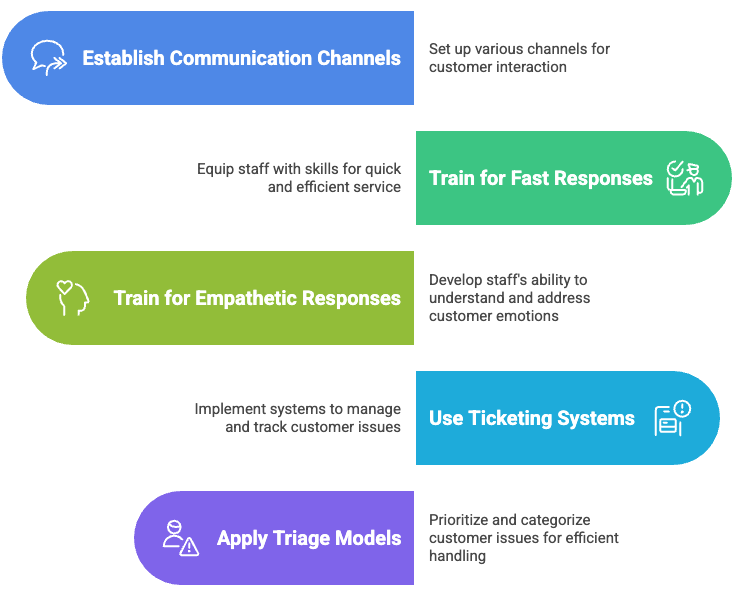
Even if you're amazing at predicting problems, some stuff will still catch you off guard. That's where solid reactive support comes in. You need systems that work fast when customers reach out with issues you never saw coming.
Establishing communication channels
Your customers need ways to find you when things go wrong. Right now, 84% of decision makers are completely rethinking how they handle different support channels. Smart move, because people want options:
- Email (90% of service teams use this)
- Phone (still king for complicated problems)
- Live chat (fast responses that customers actually love)
- Social media (where complaints go public anyway)
Meet your customers where they already are. When people can reach you the way they prefer, they trust you more. Simple as that.
Training for fast and empathetic responses
Your team makes or breaks reactive support. Sure, they need to know your systems inside and out. But here's what really matters — they need to actually care about solving problems. Both skills together matter because 68% of customers expect their issues fixed within three hours.
Focus your training on listening first, understanding what's really wrong, then matching that problem to whatever tools you've got. Keep everyone sharp with regular training sessions too. Nobody wants to deal with a support rep who's clearly winging it.
Using ticketing systems and triage models
Think of ticketing systems like an emergency room — everything gets sorted so the most urgent stuff gets handled first. That's triage in action.
Here's a simple three-step system: spot any special needs right away, sort issues into clear categories, then make sure the right person handles each type. Urgency trumps everything else — if something's truly critical, it goes to the front of the line.
Examples of reactive customer service done right
Good reactive support looks different depending on the problem: investigating billing mix-ups and cutting refund checks on the spot; swapping out broken products without a hassle; walking someone through a password reset step-by-step; tracking down delayed packages and offering faster shipping; or turning negative feedback into real solutions that show you're listening.
The best reactive teams don't just fix problems — they make customers feel heard.
Finding the right balance in 2025
Trying to pick just one approach is like asking whether you need both brakes and gas pedals on your car. Smart businesses in 2025 aren't choosing sides anymore.
Why a hybrid approach works best
No company can predict every single customer need. That's just reality. Even with the best data and forecasting, curveballs happen. But here's what's interesting: 87% of people actually want companies to reach out proactively, while still expecting fast responses when they make the first move.
We're seeing hybrid models become the new standard in 2025. AI handles the routine stuff, humans tackle the complex emotional situations. Companies using proactive strategies see retention jump by 3-5%, but that doesn't mean reactive support becomes less important. Both matter.
How to transition from reactive to proactive
Start with clear team roles. Your reactive folks should focus on speed and conflict resolution, while proactive teams need analytical skills to spot patterns. Different skills, different goals.
Get your teams talking to each other. When support shares what they're seeing with product and marketing, everyone can work on preventing issues before they hit customers.
Good documentation alone can cut your support volume by. Track what's working with metrics that actually matter:
- How many issues get resolved automatically
- Which knowledge base articles close tickets
- Customer retention numbers
- Product engagement stats
Conclusion
Look, the whole Proactive vs Reactive Customer Service debate misses the point. It's like asking whether you need both brakes and a steering wheel in your car — of course you need both.
We've walked through when to jump ahead of problems and when to respond quickly to surprises. The companies doing this well aren't picking teams. They're building systems that can do both, because customers don't care about your internal processes — they just want their issues handled.
Your customers want you to catch problems before they happen, but they also want fast help when something unexpected pops up. Makes sense, right? That's exactly why a mixed approach works better than going all-in on either strategy.
The shift toward this balanced approach takes some work upfront. You'll need to set up better data tracking, train your team differently, and probably invest in some new tools. But here's what's interesting — the businesses making this transition are seeing customers stick around longer and complain less often.
Think about 2025 as your chance to get ahead of this trend. Use data to spot patterns and prevent common issues, but keep your human team ready for the curveballs. When you can prevent problems AND solve them quickly when they do happen, customer service stops being just a cost center. It becomes the reason people choose you over everyone else.
Quick summary: Proactive vs reactive customer service
Most customers don't complain when something goes wrong—they simply leave. In 2025, businesses face a critical choice in their support strategy, but the smartest companies have discovered that Proactive vs Reactive Customer Service isn't really about picking sides. It's about creating seamless experiences that anticipate problems while staying ready for the unexpected.
- Proactive service catches issues before they reach customers—like Amazon predicting shipping delays and reaching out first with solutions
- Reactive service excels when handling complex, unpredictable situations that need genuine human empathy and problem-solving
- Companies using hybrid approaches transform customer service from cost centers into loyalty-building engines
- Smart data analytics reveal patterns that prevent common frustrations before they happen
- Self-service resources empower customers while freeing teams to handle what truly matters
The Proactive vs Reactive Customer Service debate misses the real opportunity. Forward-thinking businesses build systems that prevent problems AND solve them brilliantly when they occur. By combining predictive insights with responsive human touch, companies create the kind of support experience that turns frustrated customers into loyal advocates. This balanced approach doesn't just resolve issues—it builds lasting relationships.
Frequently Asked Questions
Proactive customer service is when a company anticipates customer issues or needs and addresses them before the customer reaches out. It’s about preventing problems, offering help in advance, and creating a smoother experience.
Example: Sending a warning email about a possible service delay before the customer notices it.
Reactive customer service is when a company responds to customer issues only after they happen. It’s about fixing problems once the customer reaches out for help.
Example: A customer reports a failed payment, and the support team steps in to resolve it.
Responsive customer service is when a company quickly and effectively addresses customer inquiries or problems as they arise. It focuses on speed, accuracy, and empathy in handling requests — whether through chat, email, or phone.
Example: A customer asks about a missing order, and support replies within minutes with a clear update.
Here’s how to handle a stubborn customer effectively:
- Stay calm and patient – Don’t take it personally. Keep your tone respectful.
- Listen actively – Let them vent fully without interrupting.
- Acknowledge their frustration – Show empathy: “I understand this has been frustrating.”
- Ask clarifying questions – Get to the root of the issue without being confrontational.
- Offer options, not ultimatums – Give them choices so they feel in control.
- Stay solution-focused – Keep steering the conversation toward resolving the issue.
- Know when to escalate – If it’s going nowhere, politely involve a supervisor.
Stubborn customers want to feel heard and respected — once they do, they’re often more open to a solution.
